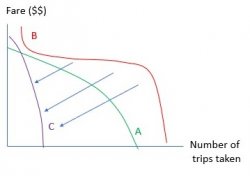Melburnian1
Veteran Member
- Joined
- Jun 7, 2013
- Posts
- 25,716
On 19 September BITRE released its July 2019 domestic air passenger figures:
The numbers carried rose only 0.2 per cent when comparing July 2019 to July 2018.
There were 23 weekdays in July 2019 compared to 22 in July 2018. Normally this should mean, all else being equal, higher patronage in July 2019 as weekdays are typically busier than Saturdays (and Sunday mornings.
The number of aircraft trips rose 3.8 per cent. This is surprising at first glance given the weak demand, but may be mostly due to the 'extra weekday.'
Load factors were down. While this does not disclose anything about yields, it must still be of concern to airlines and brings into focus Alan Joyce's comments where even he - not one to shout bad news from the pulpit unless he's after a government subsidy or bailout - has admitted that there's soft demand for leisure travel domestically.
It's hard for the overall passenger numbers to climb much when the busiest route (MEL - SYD and return) suffered a drop of 2.1 per cent in monthly passengers comparing the two Julys. The other two busiest routes (BNE - SYD and BNE - MEL) also had decreases.
Passenger numbers for the month declined even faster at SYD and MEL than the tiny rise for the whole network, with SYD dropping 0.7 per cent and MEL 0.6 per cent, while BNE rose a tiny 0.1 per cent. Interestingly PER was up 2.2 per cent. Does this reflect increased iron ore mining activity and what have been good prices for that commodity given the mining tailings dams problems experienced in competitor Brazil?
Patrons using CNS for the month declined 3.1 per cent while much smaller DRW was down 2.8 per cent. These are hefty decreases for tourism-related airports. That NT tourism is in trouble is not surprising (and has been reported by the media occasionally, although more frequently it's how the NT Labor government is close to bankrupt) but I wasn't aware that tourism (and trade?) in FNQ was depressed.
We don't generally have information about when individual tenancies at major airports are up for renewal but if these passenger decreases continue, one might expect some robust discussions from tenants demanding smaller rent increases, or even decreased rent. Our airports are notorious for charging stratospheric rents. While I don't monitor it, on occasion one notices a new tenant moving in that can be a sign the previous occupant was unable to trade profitably or sufficiently in the black.
Population in Australia overall is rising at about 1.6 per cent per annum, although there's been a cut in immigration to about 160000 per annum, so in per capita terms the number of flights being taken domestically has dropped.
As it's been discussed in another 'open discussion' thread, I'll only briefly touch on it, but while airlines (especially QF) are good at fuel hedging, one wonders whether the attacks in Saudi Arabia on storages will have an eventual flow though (no pun intended) effect meaning higher domestic air fares. This would crimp demand a bit more even if some is inelastic.
The number of people outside AFF that I know who are in business (not government) and 'constantly' fly is small, so if you are in the private sector, have you and others in your entity not changed your frequency of trips by air, have you increased these or (like the statistics) is there some sort of decrease? Or is it only leisure travellers flying less?
With the leisure travellers, I don't get the impression that they are undertaking trips by other modes (especially driving) to compensate. Some may simply be staying at home and reducing their domestic flights.
The numbers carried rose only 0.2 per cent when comparing July 2019 to July 2018.
There were 23 weekdays in July 2019 compared to 22 in July 2018. Normally this should mean, all else being equal, higher patronage in July 2019 as weekdays are typically busier than Saturdays (and Sunday mornings.
The number of aircraft trips rose 3.8 per cent. This is surprising at first glance given the weak demand, but may be mostly due to the 'extra weekday.'
Load factors were down. While this does not disclose anything about yields, it must still be of concern to airlines and brings into focus Alan Joyce's comments where even he - not one to shout bad news from the pulpit unless he's after a government subsidy or bailout - has admitted that there's soft demand for leisure travel domestically.
It's hard for the overall passenger numbers to climb much when the busiest route (MEL - SYD and return) suffered a drop of 2.1 per cent in monthly passengers comparing the two Julys. The other two busiest routes (BNE - SYD and BNE - MEL) also had decreases.
Passenger numbers for the month declined even faster at SYD and MEL than the tiny rise for the whole network, with SYD dropping 0.7 per cent and MEL 0.6 per cent, while BNE rose a tiny 0.1 per cent. Interestingly PER was up 2.2 per cent. Does this reflect increased iron ore mining activity and what have been good prices for that commodity given the mining tailings dams problems experienced in competitor Brazil?
Patrons using CNS for the month declined 3.1 per cent while much smaller DRW was down 2.8 per cent. These are hefty decreases for tourism-related airports. That NT tourism is in trouble is not surprising (and has been reported by the media occasionally, although more frequently it's how the NT Labor government is close to bankrupt) but I wasn't aware that tourism (and trade?) in FNQ was depressed.
We don't generally have information about when individual tenancies at major airports are up for renewal but if these passenger decreases continue, one might expect some robust discussions from tenants demanding smaller rent increases, or even decreased rent. Our airports are notorious for charging stratospheric rents. While I don't monitor it, on occasion one notices a new tenant moving in that can be a sign the previous occupant was unable to trade profitably or sufficiently in the black.
Population in Australia overall is rising at about 1.6 per cent per annum, although there's been a cut in immigration to about 160000 per annum, so in per capita terms the number of flights being taken domestically has dropped.
As it's been discussed in another 'open discussion' thread, I'll only briefly touch on it, but while airlines (especially QF) are good at fuel hedging, one wonders whether the attacks in Saudi Arabia on storages will have an eventual flow though (no pun intended) effect meaning higher domestic air fares. This would crimp demand a bit more even if some is inelastic.
The number of people outside AFF that I know who are in business (not government) and 'constantly' fly is small, so if you are in the private sector, have you and others in your entity not changed your frequency of trips by air, have you increased these or (like the statistics) is there some sort of decrease? Or is it only leisure travellers flying less?
With the leisure travellers, I don't get the impression that they are undertaking trips by other modes (especially driving) to compensate. Some may simply be staying at home and reducing their domestic flights.
Last edited:


















